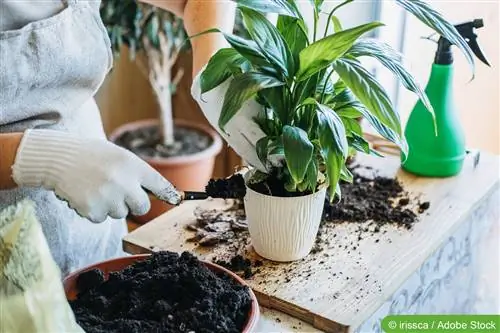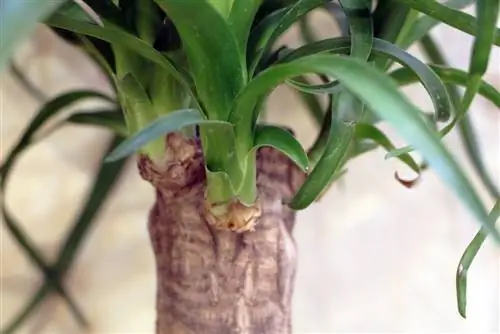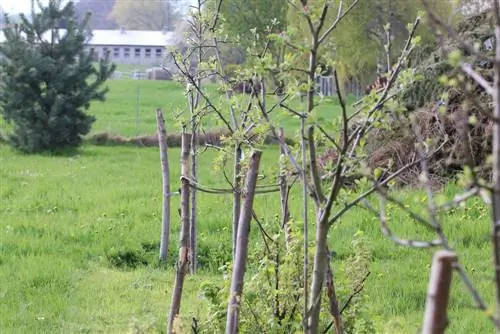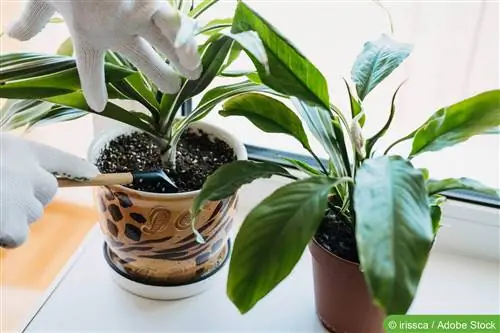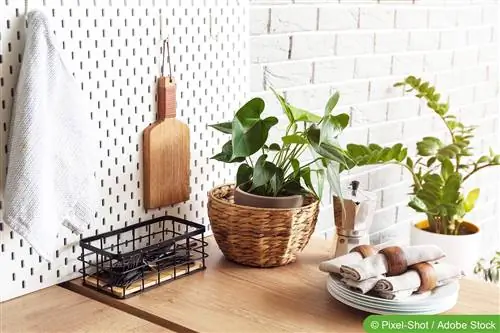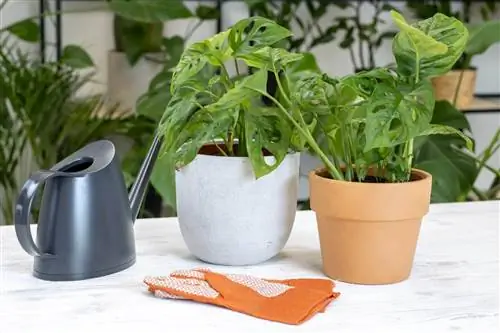- Author admin [email protected].
- Public 2023-12-17 03:39.
- Last modified 2025-01-24 12:45.
Nobody has to go without houseplants. No matter whether there is only a north and south window, whether you lack a green thumb or just lack of time. Nature has something in store for everyone. The most beautiful, exotic plants can be grown indoors in particular. True to the motto “knew how and where”. If you do everything right when it comes to light, temperature, water and nutrients, you will have a lot of fun with your green roommates in a he althy indoor climate.
Location
Before buying a plant, considering which locations I have available is only indirectly part of the care, but it can make a lot of things easier. The more perfectly the location meets the plant's requirements, the he althier and stronger it will grow. This means that it is best to check the desired location according to its characteristics (direction, radiator, window, corner of the room, humidity, etc.) before buying the houseplant. Should it be a cactus, an orchid, a fern or an African violet? The information about the origin of the plants often tells us their preferred location. Most houseplants need a place without extremes.
Tip:
If there are not enough suitable locations available, you can consider working with plant lamps within the room.
Substrate
Choosing the right substrate has a further influence on the care of houseplants. Most common houseplants do quite well with good all-round potting soil. If you want to offer your plant the perfect substrate, you have to do a little research into its natural habitat. Universal potting soil is usually compiled according to the lowest common denominator, and economic interests also play a role. The substrate can almost always be refined to suit the respective plant or put together yourself. The most important factors are:
- the permeability for water, nutrients and air
- the pH value
Water drainage can be improved by adding small pebbles, sand or polystyrene. This prevents root rot caused by waterlogging. With a pH value of 6, i.e. very slightly acidic, you are usually correct. Of course, it is also important to pay attention to the individual needs of the respective plant. Orchids, azaleas and cacti definitely need a special substrate mixed to suit their needs.
Pouring
Watering too much or too little, these are the most common care mistakes. The combination of too much water and poor drainage, i.e. waterlogging, is particularly fatal. In order to do everything right here, it is worth keeping the following five factors in mind when watering:
- Plant type
- Growth Phase
- Indoor climate
- Vessel
- Drainage
Almost all houseplants will die over time if their roots are permanently wet, unless they are swamp plants. Good drainage in the pot is just as important as pouring out water that has accumulated in the bottom bowl after watering. A vessel that cannot breathe, a glazed pot for example, will stay moist longer than a porous, unglazed clay pot. In the growth phase, a plant generally needs more water than in its resting phase. Last but not least, it is of course important to pay attention to the plant genus. Succulent, thick-leaved plants require less watering than the thin and large-leaved types. Two other parameters can play an important role, these are:
Water hardness
Almost all houseplants prefer soft to medium-hard water for irrigation. The easiest way to get it is through collected rainwater or stale tap water.
Pouring or dipping
Maintaining consistently optimal humidity for each houseplant is almost impossible. Plants are used to being exposed to particularly dry or wet times to a certain extent. Therefore, most plants appreciate having their root balls completely soaked every now and then by immersing them in a water bath.
Basically, individual treatment is preferable when watering. Most houseplants prefer to only be watered when the substrate is quite dry. A finger test, not just a superficial one, can be helpful here. During the dormant phase, usually in winter, watering is allowed less frequently. However, care must be taken all year round to determine whether dry heating air or strong sunlight require more frequent watering or not.
Tip:
Many exotic plants, especially from the tropics and subtropics, require high humidity. Watering alone is not enough here. You can either place containers with water next to them and or spray the plants frequently with water.
Fertilize
In order to absorb nutrients, houseplants only have a tiny soil biotope available. That is why regular fertilizer applications are of vital importance. Fresh, good potting soil initially contains enough nutrients. But fast-growing and, above all, flowering plants soon need additional fertilizer on a regular basis. But be careful, especially due to the limitation of the living space, over-fertilization can quickly occur. Most common houseplants get by with a universal liquid fertilizer that is added to the water every 14 days. The need for a special weighting of the proportions of nitrogen, potassium and phosphorus in a fertilizer may arise from the type of plant or the growth phase. The fertilizer proportions can be roughly divided as follows:
- Nitrogen: is responsible for the formation of chlorophyll, i.e. the green components and the general growth of the plant
- Potassium: is important for lush flowering
- Phosphorus: needed for strong and he althy roots
Cleaning
Perhaps one aspect of care that many people don't take into account is cleaning the leaves. Actually quite logical, because plants also need a “free nose” for their gas exchange. This means that the leaves of houseplants should be regularly cleaned of dust and other debris. So at least once a month is plant cleaning day. This is also a good opportunity to prevent plant pests.
Repotting
It must be repotted every two years or at the latest when the flower pot is fully rooted. This is best done after winter but before the growing season. A larger pot and fresh substrate are used. The most important factors when repotting:
- create a good drainage layer (shards of pottery, gravel or sand on top, then potting soil)
- Carefully free roots from the old soil
- When filling with new soil, keep opening the pot to avoid air holes
- pour until the water runs out from the bottom
- then do not fertilize for the first 4-6 weeks
Diseases, pests
If you water your houseplants as needed and clean them regularly, you will often recognize pests or noticeable diseases in the early stages. Then the worst can be prevented by removing the affected areas or rinsing off the pests. The location or care parameters must then be improved accordingly. Houseplants grow in isolation, outside of their natural biotope, which makes them particularly vulnerable. They are usually not able to regenerate themselves, for example with the help of predators from the environment.
Conclusion of the editors
With a houseplant you not only bring clean air and beautiful decoration into your house. Houseplants are living things too. As such, they have individual requirements for light, water and nutrients. When shopping, you should therefore have an eye on the specific needs of the houseplant and know how much time you want to invest in its care.
What you need to know about houseplant care in brief
Individual plant care
It is important to take into account that each plant requires its own specific care. Among the houseplants, there are flowers that are very easy to care for, for which you don't need a green thumb and which still thrive lushly. Well-known examples of this are the window leaf, also called monstera, the yucca palm or the rubber tree. But there are also numerous flowering plants that are easy to care for, such as African violets or cyclamens. The orchid is also one of the houseplants that requires little care.
- If you want to decorate a window seat with beautiful plants, you should pay particular attention to the plant's light needs.
- Here it is advisable to take a guide to hand, for example to only put together plants that can tolerate midday sun.
- Plant care tips for houseplants can usually be found attached to the pot when you purchase the plant.
Fertilize houseplants
Many household tips replace fertilizer, save money and help to perfectly care for and fertilize every houseplant. This also includes tips that can be used to quickly remove pests from the plant without any chemicals.
- A wonderful and very inexpensive fertilizer is coffee grounds. This is distributed evenly over the soil in the flower pots. Fertilization then occurs with every watering. Of course, the coffee grounds must be replaced regularly.
- Cold potato water for watering is also a cheap alternative to fertilizer from specialist retailers. However, only uns alted water should be used here! The nutrients contained in potato water are important for he althy plant growth.
- Water used to boil an egg also fulfills the same function.

